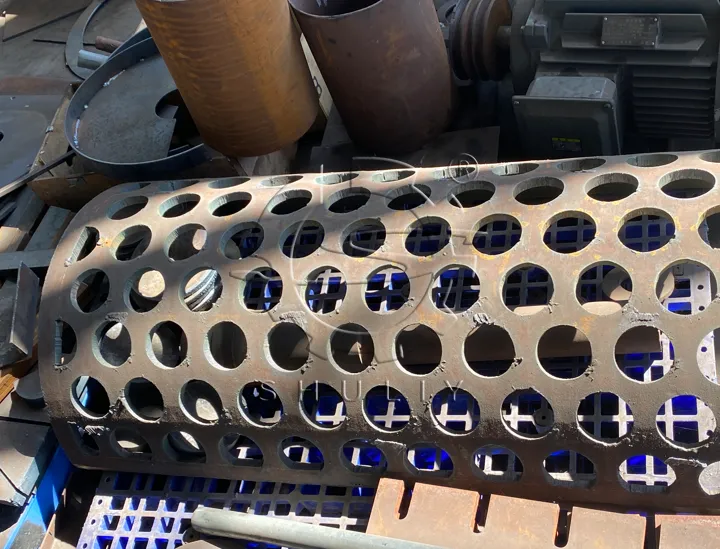How to Choose the Right Screen Size for Your Plastic Crusher (And Why a 26mm vs. 50mm Choice Matters)
In the design of a plastic recycling line, major equipment like the crusher and pelletizer receive most of the attention. Yet, a small, often overlooked component has a disproportionately large impact on the entire system’s efficiency, output quality, and even operational cost: the crusher screen. Choosing the correct plastic crusher screen size is not a minor detail; it is a strategic decision that directly influences profitability.
This guide will move beyond simple specifications and explain the technical trade-offs involved in granulator screen selection, demonstrating why a 50mm screen might be perfect for one application, while a 26mm screen is essential for another.

The Golden Triangle: How Screen Size Impacts Performance
The choice of a crusher screen aperture creates a “golden triangle” of competing performance metrics: Throughput, Particle Size, and Energy/Fines. Adjusting for one will always affect the others.
1. Impact on Throughput (Capacity)
This is the most direct relationship. The effect of screen size on granulator capacity is a simple matter of physics: larger holes allow material to exit the cutting chamber faster.
- Larger Screen (e.g., 50mm): Allows for maximum material discharge, leading to higher throughput (kg/h). This is the primary choice when the goal is to increase plastic crusher throughput.
- Smaller Screen (e.g., 26mm): Restricts material flow, forcing it to remain in the chamber longer for further size reduction. This inherently lowers the overall capacity.
2. Impact on Particle Size & Quality
The screen acts as the final gatekeeper; it is the sole component that determines the maximum crusher output particle size.
- What it means: A 50mm screen will produce flakes that are no larger than 50mm in their largest dimension. The goal is achieving a uniformity of crushed plastic that is ideal for the next processing stage. A consistent plastic flake quality and size is critical for efficient washing and stable feeding into a plastic pelletizing machine. If your goal is to get smaller plastic flakes, selecting a smaller screen size is the direct solution.
3. Impact on Fines & Energy Consumption
The longer material stays in the cutting chamber, the more it is impacted by the rotor knives.
- Reducing Fines: A smaller screen increases residence time, which can lead to over-processing and the creation of “fines” (dust or powder). If you’re asking, “why is my granulator producing too much dust?”, your screen may be too small for the material, or your blades could be dull.
- Energy Consumption: Increased residence time means the motor works harder to process the same amount of material, leading to higher plastic crusher energy consumption.
Practical Guide: Matching the Right Plastic Crusher Screen Size to Your Material
The theoretical trade-offs become clear when applied to real-world materials. The choice of screen size for hard plastic vs. soft plastic is fundamentally different.
For Hard, Rigid Plastics (PET, HDPE, PVC)
When processing materials like PET bottles or HDPE drums, the primary goal is usually high throughput. These materials are brittle and shatter easily upon impact.
- Recommendation: A larger screen, typically in the 40mm-60mm range, with 50mm being the best screen size for PET bottles in many high-capacity applications.
- The Reason: The material fractures into small pieces quickly. A large screen allows these pieces to be evacuated efficiently, preventing over-grinding and maximizing the capacity of your hard plastic recycling line.
For Soft, Flexible Plastics (LDPE/LLDPE Film, PP Bags)
Flexible materials present the opposite challenge. They are elastic and tend to stretch rather than shatter.
- Recommendation: A smaller screen, typically in the 20mm-30mm range, with 26mm being a highly effective screen size for LDPE film granulation.
- The Reason: A large screen would allow long, uncut strips of film to pass through, which is unacceptable for washing and pelletizing. The smaller holes of a 26mm screen ensure the film is repeatedly cut until it is small enough to pass, guaranteeing a properly granulated output. This is a critical factor in a successful plastic film recycling line.
Troubleshooting & Maintenance FAQ
Q: How do I prevent screen blockage in my grinder?
A: Plastic crusher screen clogging is most common with films. Ensure you are using the correct smaller screen size and consider wet granulation to prevent film from melting and sticking. Q: My crushed plastic size is not uniform. What’s wrong?
A: Check for a damaged or worn-out screen. A hole or tear will allow oversized particles to pass through. Ensure the screen is securely installed. Q: How hard is it to change a plastic crusher screen?
A: On modern machines, it’s a straightforward process. Our plastic crushers are designed with an easily accessible chamber and replaceable granulator screens, allowing for a changeover in under 30 minutes. Having the right plastic crusher spare parts on hand, like different screen sizes, allows you to adapt to new materials quickly.
The screen is not just a part; it is a tool. Selecting the correct plastic crusher screen size allows you to fine-tune your entire operation, balancing the need for speed with the demand for quality.
